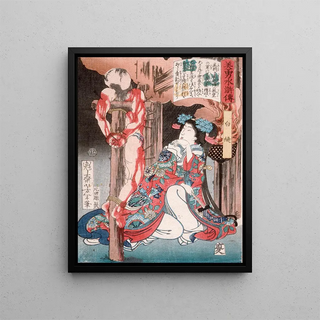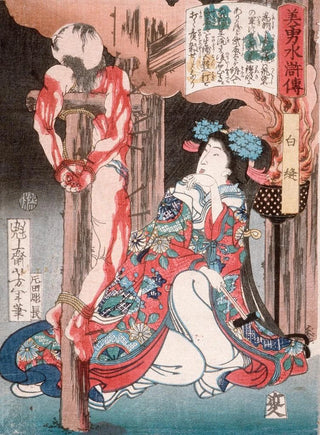Art print | Shiranui kneeling beside a crucified man - Tsukioka Yoshitoshi


View from behind

Frame (optional)
In the vast panorama of Japanese art, few works manage to capture the essence of melancholy and tragic beauty like "Shiranui kneeling beside a crucified man" by Tsukioka Yoshitoshi. This iconic piece, rooted in the tradition of ukiyo-e, evokes a profound reflection on human suffering and spirituality. Immersing oneself in this artwork, the viewer is immediately transported to a world where emotions and stories intertwine, revealing a tale of love and sacrifice. The figure of Shiranui, gracefully kneeling, embodies a silent strength, resilience in the face of adversity, while being enveloped in an aura of mystery and sadness.
Style and uniqueness of the work
Yoshitoshi's style is both bold and delicate, a perfect balance between realism and imagination. In this piece, the composition is carefully orchestrated, highlighting the intricate details of the clothing and expressions of the characters. The color palette, rich and nuanced, plays a crucial role in conveying emotions. Dark and luminous tones coexist, creating an atmosphere that is both somber and luminous, reflecting the conflict between life and death. Shiranui's posture, with her head bowed and hands clasped, suggests a prayer or plea, while the crucified man in the background symbolizes ultimate sacrifice. This juxtaposition of heroism and vulnerability is what makes this artwork so unique and captivating.
The artist and his influence
Tsukioka Yoshitoshi, a major figure of ukiyo-e, reinvented this traditional art form by incorporating contemporary elements and darker themes. Born in 1839, he experienced periods of social and political upheaval in Japan, which profoundly influenced his work. Yoshitoshi is recognized for his ability to capture scenes of rare emotional intensity, often inspired by legends, historical tales, and episodes from daily life. His work marked a transition in art

Matte finish

View from behind

Frame (optional)
In the vast panorama of Japanese art, few works manage to capture the essence of melancholy and tragic beauty like "Shiranui kneeling beside a crucified man" by Tsukioka Yoshitoshi. This iconic piece, rooted in the tradition of ukiyo-e, evokes a profound reflection on human suffering and spirituality. Immersing oneself in this artwork, the viewer is immediately transported to a world where emotions and stories intertwine, revealing a tale of love and sacrifice. The figure of Shiranui, gracefully kneeling, embodies a silent strength, resilience in the face of adversity, while being enveloped in an aura of mystery and sadness.
Style and uniqueness of the work
Yoshitoshi's style is both bold and delicate, a perfect balance between realism and imagination. In this piece, the composition is carefully orchestrated, highlighting the intricate details of the clothing and expressions of the characters. The color palette, rich and nuanced, plays a crucial role in conveying emotions. Dark and luminous tones coexist, creating an atmosphere that is both somber and luminous, reflecting the conflict between life and death. Shiranui's posture, with her head bowed and hands clasped, suggests a prayer or plea, while the crucified man in the background symbolizes ultimate sacrifice. This juxtaposition of heroism and vulnerability is what makes this artwork so unique and captivating.
The artist and his influence
Tsukioka Yoshitoshi, a major figure of ukiyo-e, reinvented this traditional art form by incorporating contemporary elements and darker themes. Born in 1839, he experienced periods of social and political upheaval in Japan, which profoundly influenced his work. Yoshitoshi is recognized for his ability to capture scenes of rare emotional intensity, often inspired by legends, historical tales, and episodes from daily life. His work marked a transition in art






